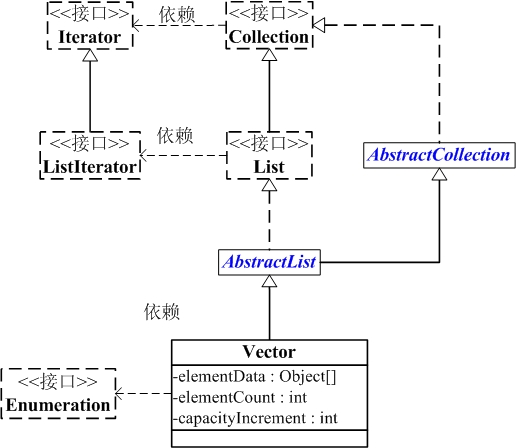概论
学完ArrayList和LinkedList之后,我们接着学习Vector。学习方式还是和之前一样,先对Vector有个整体认识,然后再学习它的源码;最后再通过实例来学会使用它。
第1部分 Vector介绍
Vector简介
Vector 是矢量队列,它是JDK1.0版本添加的类。继承于AbstractList,实现了List, RandomAccess, Cloneable这些接口。 Vector 继承了AbstractList,实现了List;所以,它是一个队列,支持相关的添加、删除、修改、遍历等功能。 Vector 实现了RandmoAccess接口,即提供了随机访问功能。RandmoAccess是java中用来被List实现,为List提供快速访问功能的。在Vector中,我们即可以通过元素的序号快速获取元素对象;这就是快速随机访问。 Vector 实现了Cloneable接口,即实现clone()函数。它能被克隆。
和ArrayList不同,Vector中的操作是线程安全的。
Vector的构造函数
Vector共有4个构造函数// 默认构造函数Vector()// capacity是Vector的默认容量大小。当由于增加数据导致容量增加时,每次容量会增加一倍。Vector(int capacity)// capacity是Vector的默认容量大小,capacityIncrement是每次Vector容量增加时的增量值。Vector(int capacity, int capacityIncrement)// 创建一个包含collection的VectorVector(Collection<? extends E> collection)
Vector的API
synchronized boolean add(E object) void add(int location, E object)synchronized boolean addAll(Collection<? extends E> collection)synchronized boolean addAll(int location, Collection<? extends E> collection)synchronized void addElement(E object)synchronized int capacity() void clear()synchronized Object clone() boolean contains(Object object)synchronized boolean containsAll(Collection<?> collection)synchronized void copyInto(Object[] elements)synchronized E elementAt(int location) Enumeration<E> elements()synchronized void ensureCapacity(int minimumCapacity)synchronized boolean equals(Object object)synchronized E firstElement() E get(int location)synchronized int hashCode()synchronized int indexOf(Object object, int location) int indexOf(Object object)synchronized void insertElementAt(E object, int location)synchronized boolean isEmpty()synchronized E lastElement()synchronized int lastIndexOf(Object object, int location)synchronized int lastIndexOf(Object object)synchronized E remove(int location) boolean remove(Object object)synchronized boolean removeAll(Collection<?> collection)synchronized void removeAllElements()synchronized boolean removeElement(Object object)synchronized void removeElementAt(int location)synchronized boolean retainAll(Collection<?> collection)synchronized E set(int location, E object)synchronized void setElementAt(E object, int location)synchronized void setSize(int length)synchronized int size()synchronized List<E> subList(int start, int end)synchronized <T> T[] toArray(T[] contents)synchronized Object[] toArray()synchronized String toString()synchronized void trimToSize()
第2部分 Vector数据结构
Vector的继承关系
java.lang.Object
java.util.AbstractCollection<E>
java.util.AbstractList<E>
java.util.Vector<E>public class Vector<E> extends AbstractList<E> implements List<E>, RandomAccess, Cloneable, java.io.Serializable {}Vector与Collection关系如下图: 
elementData , elementCount, capacityIncrement。
(01) elementData 是"Object[]类型的数组",它保存了添加到Vector中的元素。elementData是个动态数组,如果初始化Vector时,没指定动态数组的>大小,则使用默认大小10。随着Vector中元素的增加,Vector的容量也会动态增长,capacityIncrement是与容量增长相关的增长系数,具体的增长方式,请参考源码分析中的ensureCapacity()函数。
(02) elementCount 是动态数组的实际大小。
(03) capacityIncrement 是动态数组的增长系数。如果在创建Vector时,指定了capacityIncrement的大小;则,每次当Vector中动态数组容量增加时>,增加的大小都是capacityIncrement。
第3部分 Vector源码解析(基于JDK1.6.0_45)
为了更了解Vector的原理,下面对Vector源码代码作出分析。
package java.util;public class Vector<E> extends AbstractList<E> implements List<E>, RandomAccess, Cloneable, java.io.Serializable{
// 保存Vector中数据的数组
protected Object[] elementData; // 实际数据的数量
protected int elementCount; // 容量增长系数
protected int capacityIncrement; // Vector的序列版本号
private static final long serialVersionUID = -2767605614048989439L; // Vector构造函数。默认容量是10。
public Vector() { this(10);
} // 指定Vector容量大小的构造函数
public Vector(int initialCapacity) { this(initialCapacity, 0);
} // 指定Vector"容量大小"和"增长系数"的构造函数
public Vector(int initialCapacity, int capacityIncrement) { super(); if (initialCapacity < 0) throw new IllegalArgumentException("Illegal Capacity: "+
initialCapacity); // 新建一个数组,数组容量是initialCapacity
this.elementData = new Object[initialCapacity]; // 设置容量增长系数
this.capacityIncrement = capacityIncrement;
} // 指定集合的Vector构造函数。
public Vector(Collection<? extends E> c) { // 获取“集合(c)”的数组,并将其赋值给elementData
elementData = c.toArray(); // 设置数组长度
elementCount = elementData.length; // c.toArray might (incorrectly) not return Object[] (see 6260652)
if (elementData.getClass() != Object[].class)
elementData = Arrays.copyOf(elementData, elementCount, Object[].class);
} // 将数组Vector的全部元素都拷贝到数组anArray中
public synchronized void copyInto(Object[] anArray) {
System.arraycopy(elementData, 0, anArray, 0, elementCount);
} // 将当前容量值设为 =实际元素个数
public synchronized void trimToSize() {
modCount++; int oldCapacity = elementData.length; if (elementCount < oldCapacity) {
elementData = Arrays.copyOf(elementData, elementCount);
}
} // 确认“Vector容量”的帮助函数
private void ensureCapacityHelper(int minCapacity) { int oldCapacity = elementData.length; // 当Vector的容量不足以容纳当前的全部元素,增加容量大小。
// 若 容量增量系数>0(即capacityIncrement>0),则将容量增大当capacityIncrement
// 否则,将容量增大一倍。
if (minCapacity > oldCapacity) {
Object[] oldData = elementData; int newCapacity = (capacityIncrement > 0) ?
(oldCapacity + capacityIncrement) : (oldCapacity * 2); if (newCapacity < minCapacity) {
newCapacity = minCapacity;
}
elementData = Arrays.copyOf(elementData, newCapacity);
}
} // 确定Vector的容量。
public synchronized void ensureCapacity(int minCapacity) { // 将Vector的改变统计数+1
modCount++;
ensureCapacityHelper(minCapacity);
} // 设置容量值为 newSize
public synchronized void setSize(int newSize) {
modCount++; if (newSize > elementCount) { // 若 "newSize 大于 Vector容量",则调整Vector的大小。
ensureCapacityHelper(newSize);
} else { // 若 "newSize 小于/等于 Vector容量",则将newSize位置开始的元素都设置为null
for (int i = newSize ; i < elementCount ; i++) {
elementData[i] = null;
}
}
elementCount = newSize;
} // 返回“Vector的总的容量”
public synchronized int capacity() { return elementData.length;
} // 返回“Vector的实际大小”,即Vector中元素个数
public synchronized int size() { return elementCount;
} // 判断Vector是否为空
public synchronized boolean isEmpty() { return elementCount == 0;
} // 返回“Vector中全部元素对应的Enumeration”
public Enumeration<E> elements() { // 通过匿名类实现Enumeration
return new Enumeration<E>() { int count = 0; // 是否存在下一个元素
public boolean hasMoreElements() { return count < elementCount;
} // 获取下一个元素
public E nextElement() { synchronized (Vector.this) { if (count < elementCount) { return (E)elementData[count++];
}
} throw new NoSuchElementException("Vector Enumeration");
}
};
} // 返回Vector中是否包含对象(o)
public boolean contains(Object o) { return indexOf(o, 0) >= 0;
} // 从index位置开始向后查找元素(o)。
// 若找到,则返回元素的索引值;否则,返回-1
public synchronized int indexOf(Object o, int index) { if (o == null) { // 若查找元素为null,则正向找出null元素,并返回它对应的序号
for (int i = index ; i < elementCount ; i++) if (elementData[i]==null) return i;
} else { // 若查找元素不为null,则正向找出该元素,并返回它对应的序号
for (int i = index ; i < elementCount ; i++) if (o.equals(elementData[i])) return i;
} return -1;
} // 查找并返回元素(o)在Vector中的索引值
public int indexOf(Object o) { return indexOf(o, 0);
} // 从后向前查找元素(o)。并返回元素的索引
public synchronized int lastIndexOf(Object o) { return lastIndexOf(o, elementCount-1);
} // 从后向前查找元素(o)。开始位置是从前向后的第index个数;
// 若找到,则返回元素的“索引值”;否则,返回-1。
public synchronized int lastIndexOf(Object o, int index) { if (index >= elementCount) throw new IndexOutOfBoundsException(index + " >= "+ elementCount); if (o == null) { // 若查找元素为null,则反向找出null元素,并返回它对应的序号
for (int i = index; i >= 0; i--) if (elementData[i]==null) return i;
} else { // 若查找元素不为null,则反向找出该元素,并返回它对应的序号
for (int i = index; i >= 0; i--) if (o.equals(elementData[i])) return i;
} return -1;
} // 返回Vector中index位置的元素。
// 若index月结,则抛出异常
public synchronized E elementAt(int index) { if (index >= elementCount) { throw new ArrayIndexOutOfBoundsException(index + " >= " + elementCount);
} return (E)elementData[index];
} // 获取Vector中的第一个元素。
// 若失败,则抛出异常!
public synchronized E firstElement() { if (elementCount == 0) { throw new NoSuchElementException();
} return (E)elementData[0];
} // 获取Vector中的最后一个元素。
// 若失败,则抛出异常!
public synchronized E lastElement() { if (elementCount == 0) { throw new NoSuchElementException();
} return (E)elementData[elementCount - 1];
} // 设置index位置的元素值为obj
public synchronized void setElementAt(E obj, int index) { if (index >= elementCount) { throw new ArrayIndexOutOfBoundsException(index + " >= " +
elementCount);
}
elementData[index] = obj;
} // 删除index位置的元素
public synchronized void removeElementAt(int index) {
modCount++; if (index >= elementCount) { throw new ArrayIndexOutOfBoundsException(index + " >= " +
elementCount);
} else if (index < 0) { throw new ArrayIndexOutOfBoundsException(index);
} int j = elementCount - index - 1; if (j > 0) {
System.arraycopy(elementData, index + 1, elementData, index, j);
}
elementCount--;
elementData[elementCount] = null; /* to let gc do its work */
} // 在index位置处插入元素(obj)
public synchronized void insertElementAt(E obj, int index) {
modCount++; if (index > elementCount) { throw new ArrayIndexOutOfBoundsException(index
+ " > " + elementCount);
}
ensureCapacityHelper(elementCount + 1);
System.arraycopy(elementData, index, elementData, index + 1, elementCount - index);
elementData[index] = obj;
elementCount++;
} // 将“元素obj”添加到Vector末尾
public synchronized void addElement(E obj) {
modCount++;
ensureCapacityHelper(elementCount + 1);
elementData[elementCount++] = obj;
} // 在Vector中查找并删除元素obj。
// 成功的话,返回true;否则,返回false。
public synchronized boolean removeElement(Object obj) {
modCount++; int i = indexOf(obj); if (i >= 0) {
removeElementAt(i); return true;
} return false;
} // 删除Vector中的全部元素
public synchronized void removeAllElements() {
modCount++; // 将Vector中的全部元素设为null
for (int i = 0; i < elementCount; i++)
elementData[i] = null;
elementCount = 0;
} // 克隆函数
public synchronized Object clone() { try {
Vector<E> v = (Vector<E>) super.clone(); // 将当前Vector的全部元素拷贝到v中
v.elementData = Arrays.copyOf(elementData, elementCount);
v.modCount = 0; return v;
} catch (CloneNotSupportedException e) { // this shouldn't happen, since we are Cloneable
throw new InternalError();
}
} // 返回Object数组
public synchronized Object[] toArray() { return Arrays.copyOf(elementData, elementCount);
} // 返回Vector的模板数组。所谓模板数组,即可以将T设为任意的数据类型
public synchronized <T> T[] toArray(T[] a) { // 若数组a的大小 < Vector的元素个数;
// 则新建一个T[]数组,数组大小是“Vector的元素个数”,并将“Vector”全部拷贝到新数组中
if (a.length < elementCount) return (T[]) Arrays.copyOf(elementData, elementCount, a.getClass()); // 若数组a的大小 >= Vector的元素个数;
// 则将Vector的全部元素都拷贝到数组a中。
System.arraycopy(elementData, 0, a, 0, elementCount); if (a.length > elementCount)
a[elementCount] = null; return a;
} // 获取index位置的元素
public synchronized E get(int index) { if (index >= elementCount) throw new ArrayIndexOutOfBoundsException(index); return (E)elementData[index];
} // 设置index位置的值为element。并返回index位置的原始值
public synchronized E set(int index, E element) { if (index >= elementCount) throw new ArrayIndexOutOfBoundsException(index);
Object oldValue = elementData[index];
elementData[index] = element; return (E)oldValue;
} // 将“元素e”添加到Vector最后。
public synchronized boolean add(E e) {
modCount++;
ensureCapacityHelper(elementCount + 1);
elementData[elementCount++] = e; return true;
} // 删除Vector中的元素o
public boolean remove(Object o) { return removeElement(o);
} // 在index位置添加元素element
public void add(int index, E element) {
insertElementAt(element, index);
} // 删除index位置的元素,并返回index位置的原始值
public synchronized E remove(int index) {
modCount++; if (index >= elementCount) throw new ArrayIndexOutOfBoundsException(index);
Object oldValue = elementData[index]; int numMoved = elementCount - index - 1; if (numMoved > 0)
System.arraycopy(elementData, index+1, elementData, index,
numMoved);
elementData[--elementCount] = null; // Let gc do its work
return (E)oldValue;
} // 清空Vector
public void clear() {
removeAllElements();
} // 返回Vector是否包含集合c
public synchronized boolean containsAll(Collection<?> c) { return super.containsAll(c);
} // 将集合c添加到Vector中
public synchronized boolean addAll(Collection<? extends E> c) {
modCount++;
Object[] a = c.toArray(); int numNew = a.length;
ensureCapacityHelper(elementCount + numNew); // 将集合c的全部元素拷贝到数组elementData中
System.arraycopy(a, 0, elementData, elementCount, numNew);
elementCount += numNew; return numNew != 0;
} // 删除集合c的全部元素
public synchronized boolean removeAll(Collection<?> c) { return super.removeAll(c);
} // 删除“非集合c中的元素”
public synchronized boolean retainAll(Collection<?> c) { return super.retainAll(c);
} // 从index位置开始,将集合c添加到Vector中
public synchronized boolean addAll(int index, Collection<? extends E> c) {
modCount++; if (index < 0 || index > elementCount) throw new ArrayIndexOutOfBoundsException(index);
Object[] a = c.toArray(); int numNew = a.length;
ensureCapacityHelper(elementCount + numNew); int numMoved = elementCount - index; if (numMoved > 0)
System.arraycopy(elementData, index, elementData, index + numNew, numMoved);
System.arraycopy(a, 0, elementData, index, numNew);
elementCount += numNew; return numNew != 0;
} // 返回两个对象是否相等
public synchronized boolean equals(Object o) { return super.equals(o);
} // 计算哈希值
public synchronized int hashCode() { return super.hashCode();
} // 调用父类的toString()
public synchronized String toString() { return super.toString();
} // 获取Vector中fromIndex(包括)到toIndex(不包括)的子集
public synchronized List<E> subList(int fromIndex, int toIndex) { return Collections.synchronizedList(super.subList(fromIndex, toIndex), this);
} // 删除Vector中fromIndex到toIndex的元素
protected synchronized void removeRange(int fromIndex, int toIndex) {
modCount++; int numMoved = elementCount - toIndex;
System.arraycopy(elementData, toIndex, elementData, fromIndex,
numMoved); // Let gc do its work
int newElementCount = elementCount - (toIndex-fromIndex); while (elementCount != newElementCount)
elementData[--elementCount] = null;
} // java.io.Serializable的写入函数
private synchronized void writeObject(java.io.ObjectOutputStream s)
throws java.io.IOException {
s.defaultWriteObject();
}
}总结: (01) Vector实际上是通过一个数组去保存数据的。当我们构造Vecotr时;若使用默认构造函数,则Vector的默认容量大小是10。 (02) 当Vector容量不足以容纳全部元素时,Vector的容量会增加。若容量增加系数 >0,则将容量的值增加“容量增加系数”;否则,将容量大小增加一倍。 (03) Vector的克隆函数,即是将全部元素克隆到一个数组中。
第4部分 Vector遍历方式
Vector支持4种遍历方式。建议使用下面的第二种去遍历Vector,因为效率问题。
(01) 第一种,通过迭代器遍历。即通过Iterator去遍历。
Integer value = null;int size = vec.size();for (int i=0; i<size; i++) {
value = (Integer)vec.get(i);
}(02) 第二种,随机访问,通过索引值去遍历。 由于Vector实现了RandomAccess接口,它支持通过索引值去随机访问元素。
Integer value = null;int size = vec.size();for (int i=0; i<size; i++) {
value = (Integer)vec.get(i);
}(03) 第三种,另一种for循环。如下:
Integer value = null;for (Integer integ:vec) { value = integ;
}(04) 第四种,Enumeration遍历。如下:
Integer value = null;Enumeration enu = vec.elements();while (enu.hasMoreElements()) { value = (Integer)enu.nextElement();
}测试这些遍历方式效率的代码如下:
import java.util.*;/*
* @desc Vector遍历方式和效率的测试程序。
*
* @author skywang
*/public class VectorRandomAccessTest { public static void main(String[] args) {
Vector vec= new Vector(); for (int i=0; i<100000; i++)
vec.add(i);
iteratorThroughRandomAccess(vec) ;
iteratorThroughIterator(vec) ;
iteratorThroughFor2(vec) ;
iteratorThroughEnumeration(vec) ;
} private static void isRandomAccessSupported(List list) { if (list instanceof RandomAccess) {
System.out.println("RandomAccess implemented!");
} else {
System.out.println("RandomAccess not implemented!");
}
} public static void iteratorThroughRandomAccess(List list) { long startTime; long endTime;
startTime = System.currentTimeMillis(); for (int i=0; i<list.size(); i++) { list.get(i);
}
endTime = System.currentTimeMillis(); long interval = endTime - startTime;
System.out.println("iteratorThroughRandomAccess:" + interval+" ms");
} public static void iteratorThroughIterator(List list) { long startTime; long endTime;
startTime = System.currentTimeMillis(); for(Iterator iter = list.iterator(); iter.hasNext(); ) {
iter.next();
}
endTime = System.currentTimeMillis(); long interval = endTime - startTime;
System.out.println("iteratorThroughIterator:" + interval+" ms");
} public static void iteratorThroughFor2(List list) { long startTime; long endTime;
startTime = System.currentTimeMillis(); for(Object obj:list)
;
endTime = System.currentTimeMillis(); long interval = endTime - startTime;
System.out.println("iteratorThroughFor2:" + interval+" ms");
} public static void iteratorThroughEnumeration(Vector vec) { long startTime; long endTime;
startTime = System.currentTimeMillis(); for(Enumeration enu = vec.elements(); enu.hasMoreElements(); ) {
enu.nextElement();
}
endTime = System.currentTimeMillis(); long interval = endTime - startTime;
System.out.println("iteratorThroughEnumeration:" + interval+" ms");
}
}运行结果:
iteratorThroughRandomAccess:6 ms iteratorThroughIterator:9 ms iteratorThroughFor2:8 ms iteratorThroughEnumeration:7 ms
总结: 遍历Vector,使用索引的随机访问方式最快,使用迭代器最慢。
第5部分 Vector示例
下面通过示例学习如何使用Vector
import java.util.Vector;import java.util.List;import java.util.Iterator;import java.util.Enumeration;/**
* @desc Vector测试函数:遍历Vector和常用API
*
* @author skywang
*/public class VectorTest { public static void main(String[] args) { // 新建Vector
Vector vec = new Vector();
// 添加元素
vec.add("1");
vec.add("2");
vec.add("3");
vec.add("4");
vec.add("5"); // 设置第一个元素为100
vec.set(0, "100"); // 将“500”插入到第3个位置
vec.add(2, "300"); System.out.println("vec:"+vec); // (顺序查找)获取100的索引
System.out.println("vec.indexOf(100):"+vec.indexOf("100")); // (倒序查找)获取100的索引
System.out.println("vec.lastIndexOf(100):"+vec.lastIndexOf("100")); // 获取第一个元素
System.out.println("vec.firstElement():"+vec.firstElement()); // 获取第3个元素
System.out.println("vec.elementAt(2):"+vec.elementAt(2)); // 获取最后一个元素
System.out.println("vec.lastElement():"+vec.lastElement()); // 获取Vector的大小
System.out.println("size:"+vec.size()); // 获取Vector的总的容量
System.out.println("capacity:"+vec.capacity()); // 获取vector的“第2”到“第4”个元素
System.out.println("vec 2 to 4:"+vec.subList(1, 4)); // 通过Enumeration遍历Vector
Enumeration enu = vec.elements(); while(enu.hasMoreElements()) System.out.println("nextElement():"+enu.nextElement());
Vector retainVec = new Vector();
retainVec.add("100");
retainVec.add("300"); // 获取“vec”中包含在“retainVec中的元素”的集合
System.out.println("vec.retain():"+vec.retainAll(retainVec)); System.out.println("vec:"+vec);
// 获取vec对应的String数组
String[] arr = (String[]) vec.toArray(new String[0]); for (String str:arr) System.out.println("str:"+str); // 清空Vector。clear()和removeAllElements()一样!
vec.clear();// vec.removeAllElements();
// 判断Vector是否为空
System.out.println("vec.isEmpty():"+vec.isEmpty());
}
}运行结果:
vec:[100, 2, 300, 3, 4, 5] vec.indexOf(100):0 vec.lastIndexOf(100):0 vec.firstElement():100 vec.elementAt(2):300 vec.lastElement():5 size:6 capacity:10 vec 2 to 4:[2, 300, 3] nextElement():100 nextElement():2 nextElement():300 nextElement():3 nextElement():4 nextElement():5 vec.retain():true vec:[100, 300] str:100 str:300 vec.isEmpty():true
作者:sihailoveyan
来源:https://my.oschina.net/ouyangsihai/blog/1813785
共同学习,写下你的评论
作者其他优质文章





不太详细,实现之后再正式使用中肯定需要自己的登陆页面,甚至各个应用中只登陆时只需要弹出一个登陆对话框就行了,希望能有这部分的内容